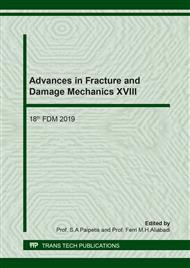p.1
p.7
p.13
p.19
p.25
p.31
p.37
p.43
Damage of Solid Phase due to Explosion Effect Using Uzawa’s Algorithm
Abstract:
The paper deals with the impact of explosion on the damage development in the structure that forms a boundary of closed or semi-closed space – tunnel - the explosion in which is initiated. In the previous publications of the author the penalty formulation of the problem was used; now Uzawa’s algorithm is applied, which appears to be more promising algorithm accelerating the iterative process of damage development in the structure. Shock waves propagating in the airspace can be described by non-linear conservation equations starting with Euler’s equations which are used to be solved by forward differences of the system of pseudo-linear equations, using Arbitrary Lagrangian-Euler Method (ALE). Conservation equations are formulated for two phases: air and solid. In the solid phase, concrete lining, the time-dependent elasticity of free rectangular elements undergoing the damage, is solved by uniformly distributed boundary elements. The paper is focused on damage to the concrete lining due to impact of the explosion in the tunnel.
Info:
Periodical:
Pages:
1-6
Citation:
Online since:
December 2019
Authors:
Price:
Сopyright:
© 2020 Trans Tech Publications Ltd. All Rights Reserved
Share:
Citation:


